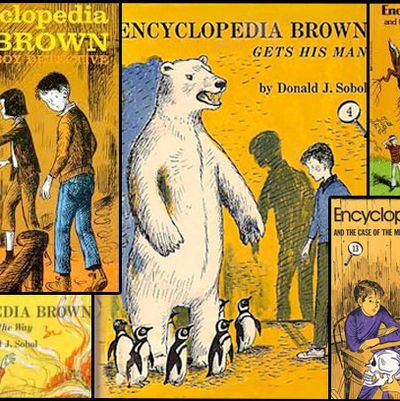
Of all the commercial operations, real and imaginary, ever launched by underage entrepreneurs — from lemonade stands to Lucy’s advice booth — the one nearest and dearest to my heart is this:
BROWN DETECTIVE AGENCY
13 ROVER AVENUE
LEROY BROWN, PRESIDENT
No Case Too Small
25¢ Per Day Plus Expenses
LEROY BROWN, PRESIDENT: that’s Encyclopedia Brown, to you. His creator, the journalist and author Donald J. Sobol, died last week at the age of 87, though the news wasn’t widely reported until today. Whereupon I promptly took myself to my local library and reverted to a habit, last practiced in 1984, of checking out, in one fell swoop, a dozen of his books.
A quick recap, in case it’s been a while since you, too, checked out his books: Encyclopedia Brown is the son of the police chief in a town so famously tough on crime that “Hardened criminals had passed the word: ‘Stay clear of Idaville.’” That’s thanks to Encyclopedia, eternal fifth-grader, voracious reader (hence the nickname), and crackerjack private eye. During the school year, Brown père recounts his toughest cases over dinner; Brown fils reliably solves them before dessert. In the summer, Encyclopedia hangs out his own shingle and foils the nefarious plans of countless kid criminals — miniature Moriarties to his miniature Holmes.
In addition to his formidable intellect, Brown possesses three features common to nearly all respectable literary detectives: a private code of conduct, a nemesis, and a sidekick. The code of conduct is a kind of one-man omertà: “He seldom spoke to anyone, not even his parents, about the help he gave to others. And he never spoke about the help he gave grownups.” The nemesis is Bugs Meany, Idaville’s thug-in-chief and ringleader of a gang called The Tigers. (Bugs Meany: has there ever been a better bad-guy name? The Genovese clan meets the playground; the villain meets, eponymously, the villainy.) The sidekick is the tomboyish Sally Kimball, who was, unusually for the era — for any era — the heavy of the operation. (“She was the only one, boy or girl, under twelve who could punch out Bugs Meany.”)
Accompanied by a large supporting cast (notorious poachers, motorcycle-riding teenage troublemakers, glamorous movie stars in town for the weekend), Encyclopedia, Sally, and Bugs star in approximately eight bazillion high-speed mysteries. These all follow the same format: three, four, a half-dozen pages, max, and then a cliffhanger of sorts at the end — a single question in all caps and bold, the textual equivalent of Hercule Poirot twirling his mustache and posing his smug rhetorical questions to the outwitted crowd at the end of a locked-door mystery. WHERE? WHY NOT? WHAT WAS THE PROOF? WHAT DID ENCYCLOPEDIA MEAN?
It was here, as a kid, that you tested not just your brains but your will. As in a textbook, the answers were at the back. Either you flipped to them straightaway — you ate, impulsively, the intellectual marshmallow — or you matched wits with your hero, gradually working your way back through a narrative so short and taut you were certain you could find the clue.
Sometimes, of course, you couldn’t. As a fellow fan, one Bryan Hartzheim, has pointed out, some of the mysteries are “ridiculously difficult.” They rely on kids knowing obscure ornithological facts, distinguishing between northern and southern names for Civil War battles, or remembering, offhand, the date the Liberty Bell cracked. But that’s the whole point: Encyclopedia was encyclopedic. I don’t remember being frustrated by this as a kid, any more than I remember being put off by the infinity of improbable things that transpire in Idaville. (“Suddenly a girl in a black leather jacket appeared at the door.” Lucky Encyclopedia!)
The truth is, before checking these books out of the library today, I didn’t actually remember much about Encyclopedia Brown — not the details, anyway. What I retained was the experience: lying on my stomach, chin in hand, my elbow gradually getting embossed by the shag carpet of my childhood bedroom, devouring the books by the dozen. For a kid who had, by then, read her way through the World Book Encyclopedia, the boy detective — that rare instance of nerd as hero — was both kindred spirit and Über-mensch. My bookishness was a liability, but his was an asset: all superpower, no radioactive sting.
But whatever was going on with Encyclopedia and me, it wasn’t just the identificatory consolations of a lonely bookworm. Nor was it only my elbow that was getting imprinted. Later on, I would read Harriet the Spy, Trixie Belden, Agatha Christie, Raymond Chandler, Sherlock Holmes, Robert Nozick, Wittgenstein. (In my mind, the line between detection and epistemology is Euclidean and clean.) But Encyclopedia Brown was the gateway detective, the antecedent of them all. From him I absorbed, unconsciously, the idea that reading is where emotional rapture meets analytic rigor. I got, right there, the crucial unity of these terms: intellectual pleasure.
Sobol once said of Encyclopedia Brown that “He is, perhaps, the boy I wanted to be.” He is the boy I wanted to be, too. I think some part of me still wants to be him — to be a detective, the way some part of me still wants to be an astronaut and an Olympic gymnast and an apprentice wizard of obscure birth and fiery temper yet bound for greatness, and all the other things I dreamed of being when I was eight years old. That’s the thing about rereading beloved childhood books: they take us so precipitously back to that era, leave us feeling so staggeringly far removed. Encyclopedia Brown and the Case of the Missing Childhood. Where did it go? I have to admit, I haven’t a clue.
Since its first publication, this post has been slightly updated with a version that ran in New York Magazine.




